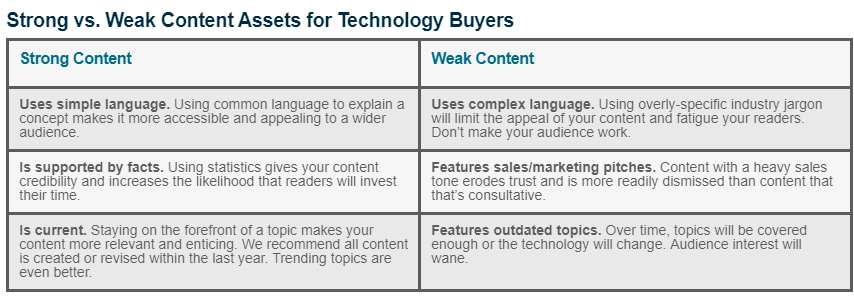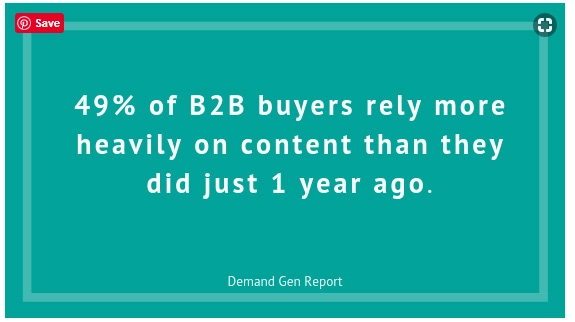
Introduction
Let’s talk about content marketing strategy.
How do you increase engagement, brand awareness, or boost conversions? Could this be something that’s causing you sleepless nights? Perhaps?
Granted. To get the attention of tech buyers across the complex B2B buying landscape is no mean feat. You need to find a way to break through the chatter.
Over and above that, you need to ensure that the right person gets the right message at the right time.
So, if you’d like tech buyers to engage with your content, below are ten tactics that can help you do just that.
1. What Content Do B2B Tech Buyers Need in Each Stage of Their Buying Journey?
One thing B2B marketers agree on is that their tech buyers pass through certain steps before they make buying decisions. Besides, it is not surprising to find a customer changing their mind in the course of their journey.
Why is this so? This is because customer needs and interests change as they progress through the buying cycle. Furthermore, they might enter or leave, move up or down, or even forwards or backward – at any stage.
Therefore, your content should address buyer needs at each stage in the cycle. Then and only then are you able to meet them wherever they are?
Just so we are on the same page, let’s unpack the four stages in the B2B tech buying cycle:
● Awareness
Prospects are researching here. They may not know that a solution to their problem exists or that you could help them. Your aim is to enlighten them about their challenges while positioning yourself as a trustworthy advisor.
You can create awareness using videos, blog posts, or posts on social media.
● Consideration
Buyers know about your service. They however still need to know more about how it can solve their problems. They need proof that it works and look to customer reviews for assurance. Use content such as case studies or testimonials to showcase how your products have helped others.
● Decision
This is the point where prospects take the final step and become tech buyers. Your content should provide the final push they need to make a purchase decision by reaffirming their trust in your brand offering.
For B2B technology buyers, their key considerations are pricing information, technical specifications, and in-depth product detail. The most ideal content here is demos, product guides, free consultations, and customer testimonials.
● Retention
Hang on, we ain’t done yet! It’s now time to turn your tech buyers into loyal fans.
Educate them on how best to use your services and products. You can also give special offers for upgrades, offer tutorials or insider guides.
2. Ensure That You Are Promoting High-Quality Content
Content is still king. And, creating engaging content is crucial to B2B marketers who want to succeed.
If your content is not high-quality, it will be much more difficult to promote. Besides, it lowers your tech buyers’ trust and negatively impacts your campaign.
Below are some key features of what constitutes strong versus weak content:

Source : b2b Marketers
When you know your audience, you will understand their concerns, wishes, and pain points. This will help you craft content that not only builds trust but creates deeper relationships too.
3. Ensure That Your Content Strategy Aligns With Your Lead Generation Goals

Source : business2community
Oftentimes, B2B marketers create content that attempts to appeal to all but fails to connect with anyone. If you want to steer clear of this problem, align your content with the results you desire.
For example, are you looking to attract numerous leads who might not match your ideal tech buyer, but could get converted through deals? Or are you more interested in high-quality prospects who are a perfect match?
There are two popular approaches you might want to consider before developing your content:
1. A High Prospect Volume Approach (Broad Content)
In this scenario, you use content themes that appeal to different personas while avoiding content that’s too technical. For example, you can use content that offers tips and tricks, suggestions on how to increase revenue or reduce expenses.
While broad content helps to catch a higher number of leads, it may lead to a bigger number of false positives.
2. A High Prospect Precision Approach (Niche Content)
Here, you use content that resonates with a specific persona or industry based on shared interests. Examples here include attracting health practitioners by promoting content that speaks their language and addresses their fears and aspirations.
Niche content tends to net fewer leads but includes a lower number of false positives.
4. Beware of Content Gaps
Is your content performing as per your expectations? No? The problem might be gaps in your funnels.
If for example, your content focuses too much on a particular stage of the buyer’s journey, this will create a “gap”. The gap forms at the point where you fail to nurture prospects causing them to leak out of your sales funnel.
A content audit will help you figure out where you have gaps and ensure that you don’t neglect any market segments.
5. Personalize Your Content Offer
Base your content offering on a prospect’s most recent interests and actions.
One way to do this is by personalizing your email marketing. Segment your prospects based on the most recent technology research behavior, then promote content directly aligned to their interests.
Amazon is a great example of personalized content marketing. Amazon Go, an innovative store with no checkout has buyers enter an Amazon store, pick what they want, and leave.
6. Target Tech Buyers by Interest
A close relative of tactic #5 is targeting buyers by interest. LinkedIn’s Interest Targeting makes it possible for tech marketers to focus on their buyer audiences through segmenting prospects by interest.
How does this work?
With Interest Targeting, marketers can engage consumers with content they know will be both interesting and enlightening. An example is, messages about a new AI solution would only be sent to people with an interest in AI.
7. Target the Right People
Ensure that your content considers all key influencers in the purchase decision. To this end, find out who they are. When you know who is crucial in a B2B sale, you can be more strategic with your content and marketing campaign.
Remember, the technology buying committee is composed of organization members who present unique perspectives. While decision-makers select, purchase and implement, influencers offer feedback during selection.
Finally, both implementers and adopters participate in the deployment and adoption of new technology while end-users use the new technology. These users are present in all the organization’s departments from sales to human resources.
8. Optimize Your Content
To deliver the right content to the right people, consider the below best practices:
- Be specific with your content and segmentation. For instance, you can base your buyer audiences on job titles such as Cloud Computing or Cloud Security.
- Ensure that your campaigns have a clear goal and a strong CTA encouraging your prospects to take action. Your content should help them decide whether a purchase decision is suitable for their business needs or not.
- Craft targeted content that elicits a ‘wow factor’. Let your content present thought leadership that’s impartial while still pushing readers to take action.
Note that tech buyers are looking for content solutions that will address their current problems. Also, they want content that aligns with their specific needs as they progress through the various buying stages.
As a B2B tech marketer, your content should showcase your expertise. Show your prospects why they should work with you and not your competition by building their trust and solving tech buyer pain.
9. Use Multiple Channels
Engage your tech buyers across multiple channels to give your content the most exposure. Post content to your blog, Twitter, and other social networks simultaneously. Build trust, educate, and drive interactions by emailing newsletters that combine original as well as curated content. this will help tech buyers to be updated.
Balance your content mix. Try using industry trends and educational content alongside your product content. Give information regarding business challenges and offer technology solutions that will propel your prospects to take the desired action.
Your newsletters can also help you to create a sense of community and build relationships with your prospects and tech buyers. Besides, they are very effective in creating awareness, driving conversations, conversion, and retention.
Finally, use blogs to re-engage buyers and keep your business top of mind.
10. Be Consistent
For best results, be consistent with your content marketing strategy. Adhoc posting on your social channels just won’t cut it. Enhance your credibility by creating a content calendar, scheduling your posts, and refreshing your blog and website.
Keep your current and potential tech buyers updated on emerging technology trends. Give tech buyers a reason to keep in touch.
Wrapping Up
There you have it. The world of technology buying is dynamic and thought leadership content is not left behind either.
As such, B2B marketers need innovative content solutions to address the needs of savvy tech buyers. Use these guidelines to shape your content marketing strategy for positive outcomes and more value to your tech buyers.
Our blog
Latest blog posts
Tool and strategies modern teams need to help their companies grow.

B2B companies must generate leads that are ready to buy their products in order to me...

In the absence of a constant flow of leads, sales teams can't meet their targets and ...

Podcasts and webinars are powerful tools that marketers can use to reach new audience...



